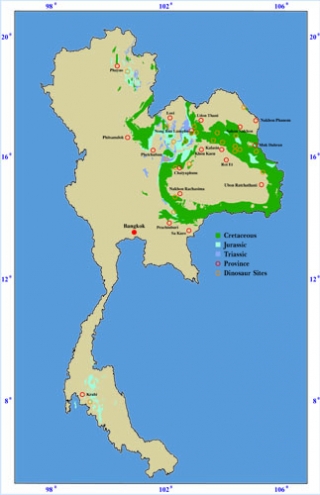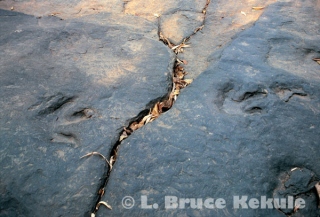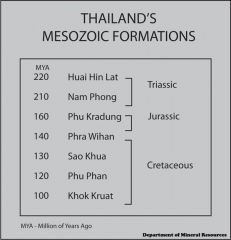Posts Tagged ‘Mesozoic vertebrates’
Thailand’s Mesozoic Vertebrates
Endemic dinosaurs once thrived on this land
Thailand’s five endemic dinosaur species
During the early Cretaceous period 140 million years ago (mya) in what is now Kalasin province in northeast Thailand, a lone theropod dinosaur walked slowly along a riverbank hunting for prey. Herbivorous dinosaurs also inhibited this land and were probably the main diet for the huge carnivore. This solitary predator walked upright. Weighing about two tons it left massive footprints 18 inches long and 12 inches across in the sandy banks of the river. Over millions of years, the sand bank eventually solidified but these footprints have miraculously remained intact. This prehistoric heritage is one of Thailand’s most important fossil sites of when the dinosaurs ruled the land.
Theropod fossil track
The Mesozoic (meaning ‘middle life’) is also known as the Age of Dinosaurs and comprised of three periods: the Triassic (248-206 mya), the Jurassic (206-144 mya) and the Cretaceous (144-65 mya). Dinosaurs evolved over 160 million years into a myriad of shapes and sizes. While some were the tallest and heaviest animals to ever walk the earth, others were no bigger than a chicken. Hundreds of species adapted to widely different environments. This adaptability contributed to the success and diversification of the dinosaur.
Thailand’s Dinosaur Sites
Thailand has the largest and finest representation of dinosaur fossils in Southeast Asia. The only other fossils in the region are from a few discoveries in Laos. Thai fossils show a close relationship to the Chinese and Mongolian dinosaurs. To date, all dinosaur fossils and footprints discovered here are from Mesozoic freshwater sediments, which has turned into clays, sandstone and limestone.
Geologic Time Scale
One man has undeniably been at the forefront of the discovery of Thai dinosaur remains. A walking encyclopedia on the subject, Varavudh Suteethorn of the Department of Mineral Resources is surely Thailand’s top paleontologist and geologist. He has found more dinosaur fossils in Thailand than anyone else, and has published scores of scientific papers. Varavudh’s has also found a stegosaur or ‘plated lizard’ and recently a carnosaur, both from the late Jurrasic. He and his team will invariably discover more new species in the future.
Theropod trackway
Eric Buffetaut and his wife Haiyan Tong of the National Center of Scientific Research in France have worked on a Thai-French project. Considered leading authorities on the identification of Thai dinosaurs, they have published many papers in collaboration with Varavudh. The meticulous work of this Thai-French paleontological team has found some 15 species in Thailand.
Thailand’s Mesozoic Formations
Thailand’s dinosaurs range from the late Triassic period to the early Cretaceous period. The first fossil was discovered in 1976 in Phu Wiang National Park in Khon Kaen province. A femur fossil from a sauropod was discovered by Sutham Yamniyom, a geologist with the Department of Mineral Resources. Then teeth from a theropod and several bones from a sauropod of the early Cretaceous were found in Phu Wiang. These were from the Sao Khua Formation, a very productive stratum.
Five new species of dinosaur known nowhere else have been found in Thailand. In 1986, Siamosaurus suteethorni, a fish-eating theropod named after Varavudh, was unearthed in Phu Wiang. It also dates from the Sao Khua Formation. In 1992, a small, parrot-beaked herbivorous dinosaur, Psittacosaurus sattayaraki, only about a meter long, was excavated in Chaiyaphum province. In 1994, the largest dinosaur ever found in Thailand appeared. A sauropod of the early Cretaceous, it was named Phuwiangosaurus sirindhornae after HRH Princess Maha Chakri Sirindhorn, who followed the excavation keenly. This giant plant-eater has been found at three sites on the Khorat Plateau.
Theropod fossil tooth
In 1996, a carnivorous theropod Siamotyrannus isanensis, was discovered and was once the oldest Tyrannosaur found in the world (but a new discovery in China is slightly older). It is one of Tyrannosaurus rex’s earliest known ancestors. The next species from the Northeast is a very primitive sauropod from the late Triassic named Isanosaurus attavipachi. It is the oldest sauropod unearthed so far. The fact that Thailand’s dinosaur discoveries have often proved to be the earliest example of lineages well known all over the world has led many scientists to believe that many dinosaur species originated in Asia.
The Kingdom’s single most significant discovery was in 1980 at Wat Sakawan, a Buddhist temple in Sahat Sakhan district, near the city of Kalasin. The temple lies at the foot of Phu Kum Khao hill and the site attracts many visitors all year round. The first fossils were found and kept at the temple. Subsequent excavations by Thai-French paleontologists discovered seven fossilized skeletons of the sauropod Phuwiangosaurus sirindhornae in the Sao Khua Formation. At the same site, several fragments of theropod teeth were also found, which suggests scavenging on the sauropod carcasses. Theropod teeth were also found together with sauropod fossil bones at Phu Wiang.
Sauropod Phuwiangosaurus sirindhornae
Thailand is the only country in Southeast Asia with fossilized dinosaur footprints, boasting nine sites in the Northeast. In 1974, the first set of theropod footprints was found on a slab of sandstone in Phu Luang Wildlife Sanctuary in Loei province. These tracks are from the Phu Phan Formation and date from about 120 mya. There are older footprints, about 140 mya, from the Phra Wihan Formation at Phu Wiang National Park. They show several paths traversed by ornithopod, theropod and sauropod dinosaurs of the early Cretaceous.
Sauropod fossil teeth
In 1996, two schoolgirls spotted two different sets of dinosaur footprints from the Phra Wihan Formation at Phu Faek Non-hunting Area in Kalasin province. The two-ton, three-toed theropod dinosaur portrayed at the beginning of this story made the clearest and best-preserved footprints in Thailand. A smaller set criss-crosses the larger set for a total of 21 footprints. The prints unfortunately lie in a seasonal stream and are covered with running water during the rainy season.
Huai Hin Lat formation 220 million years old
In 2003, a set of tracks was found by the Nam Nao Conservation Group in Nam Nao district, Phetchabun province. Villagers told of footprints that they believe had been made by the spirits of the forest. Superstition plays a big part in their lives. The conservation group contacted Varavudh Suteethorn, who investigated and determined that the tracks had been made on a huge mud flat by an archosaur or ‘ruling reptile’ sometime during the late Triassic 220 mya.
Arcosaur or ‘ruling reptile’ Triassic track
This formation is known as Huai Hin Lat. Over millions of years, the 200 by 250 meter slab somehow remained intact as geological forces thrust it up to a 40-degree angle. There are three separate track-ways, and they are the Kingdom’s oldest fossil footprints. Because this important site is situated just outside Nam Nao National Park, it is not in protected land. These important fossil sites need absolute protection for them to survive.
The downside of Thailand’s wonderful discoveries is that fossils are in big demand by both local and international collectors, stimulating village people to pillage fossil sites. Some fossils end up sold at the weekend market in Bangkok and tourist venues as curios. Scientific knowledge of millions of years of evolution is being lost to wanton ravaging of these sites. Recently, a young influential man was caught with some 300 dinosaur fossil bones waiting to be shipped abroad. Most were real and a few fakes. It is essential that such looting be controlled.
Sao Khua formation 130 million years old
Thailand is recognized as a major dinosaur site, in fact one of the richest in the world. These fossils are revealing very important information about Mesozoic dinosaurs in Asia. The joint Thai-French search for fossils continues, and surely new revelations will emerge to delight paleontologists worldwide. Thailand’s dinosaur fossils and fossilized track-ways are a special part of the Kingdom’s wild heritage, and need full protection from the authorities responsible for the natural resources.













